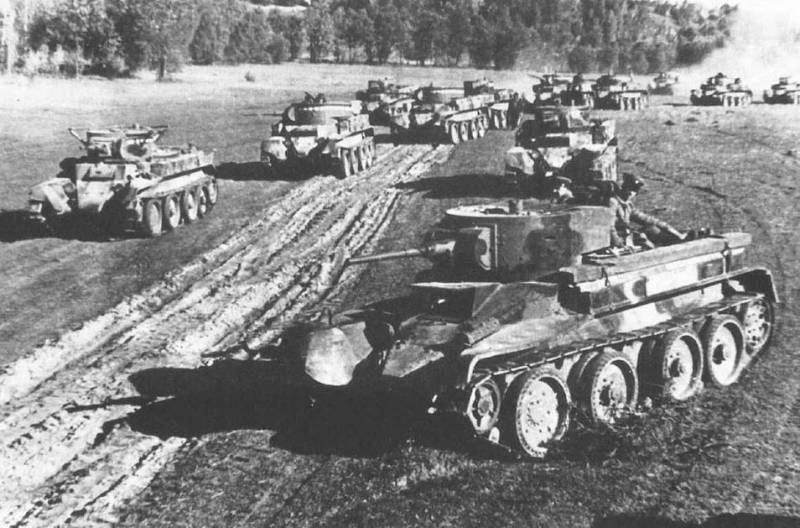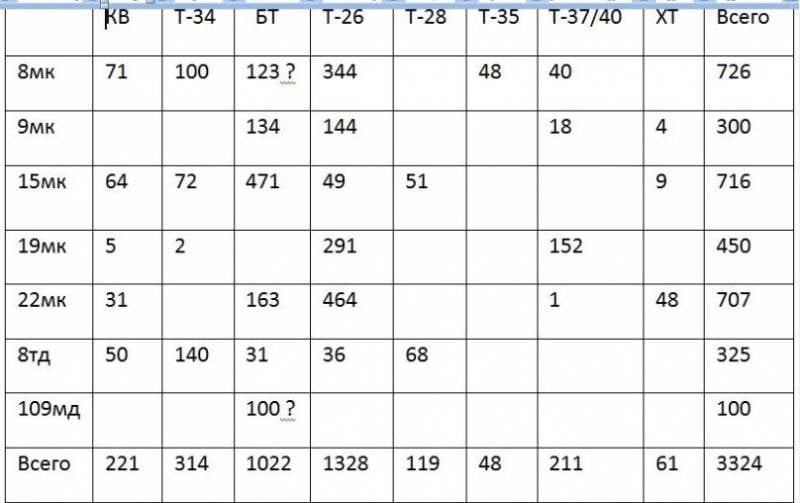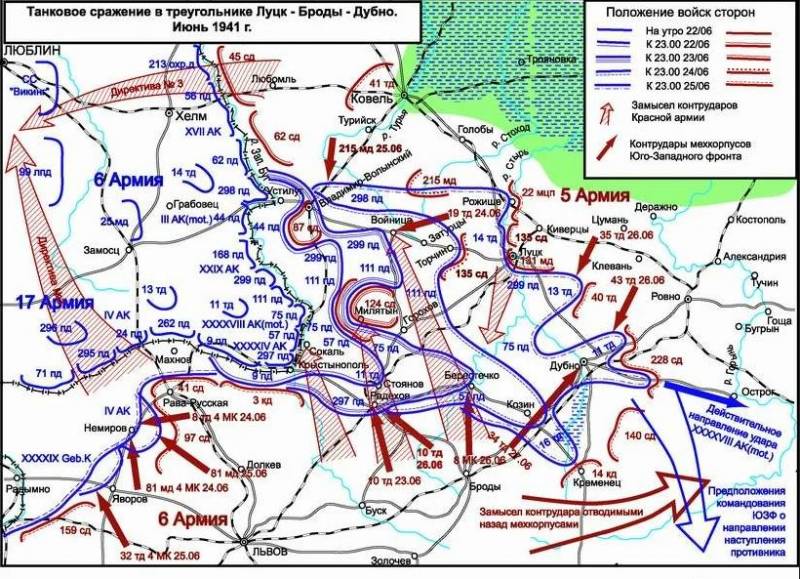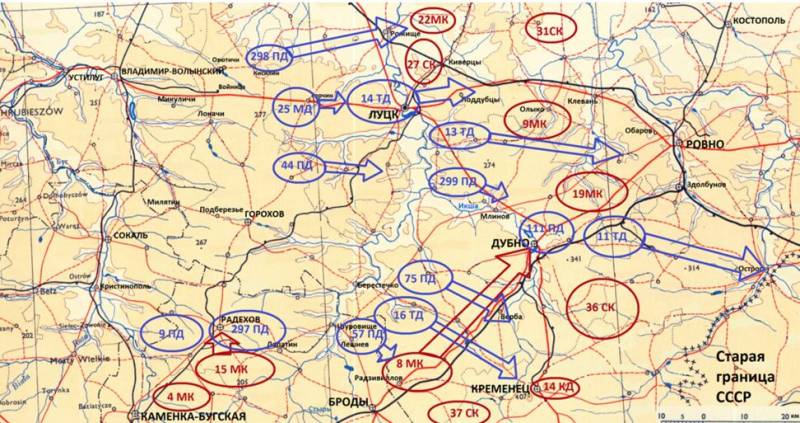Was there a counterattack in 1941 near Dubno - Lutsk - Brody tank battle
In modern sources, the counterattack of five mechanized corps of the Red Army in the first week of the war in the area of Dubno - Lutsk - Brody is often called the largest tank battle of World War II, superior to the tank battle of Prokhorovka.
In fact, this is not entirely true, there was also no tank battle near Prokhorovka on July 12, 1943, as General Rotmistrov later represented. The Fifth Guards Tank Army launched a counterattack on the enemy’s well-prepared anti-tank defenses and, sandwiched between the embankment of the railway and the floodplain of the river, suffered enormous losses from enemy artillery and tanks. Only at the final stage of the battle dozens of tanks from two sides participated in oncoming tank battles.
The German command, having fixed in the Dubno - Lutsk - Brody region an extension of large Soviet tank formations to the Kleist tank wedge, used the tactics of not an oncoming tank battle, but the organization of a solid anti-tank defense, as was the case later in the Prokhorov battle.
Plans of the Soviet command
From Dubno - Lutsk - Brody, the Soviet mechanized corps from June 24 to July 1 launched several disparate counterattacks on the German tank divisions of Kleist, did not achieve the goal to defeat and destroy the enemy, and suffered huge losses mainly from aviation and enemy artillery. At the same time, there were very few tank battles, in fact it was a “shooting” of Soviet tank formations thrown into the attack.
In contrast to the actions of the 2nd Panzer Guderian group, which at the same time organized tank mites on the flanks of the Soviet group in the Białystok region, which surrounded and destroyed five Soviet mechanized corps, the tank wedge of the 1st Panzer Group of Kleist (11td, 13td, 14 td, 16 td), having defeated the Soviet troops of the Southwestern Front on the border on June 22 and wedged deep east in the region of Radekhov, he was rapidly moving to Rivne in an attempt to break through to Kiev.
The General Staff, in its directive on June 22, ordered the South-Western Front to strike at the erupted enemy grouping from the north and from the south in the direction of Lublin, to surround and destroy the enemy.
In the evening of June 22, a representative of the Zhukovka Headquarters arrives on the South-Western Front, the front headquarters considered it impossible to carry out such an operation and offered to withdraw troops to the old border and then counterattack. This proposal was rejected and a decision was made to launch a counterattack with three mechanized corps (4th, 8th, 15th) from Radekhov and Rava-Russkaya to Krasnostav and from Vladimir-Volynsky 22mk to Krasnostav not to encircle but to defeat the enemy in oncoming battle.
The unexpected capture of Radekhov on the morning of June 23 by the German 11th and the breakthrough to Berestechko forced the Soviet command to reconsider the previous decision and launch a counterattack not on Krasnostav, but on the wedged Kleist group in the Brody - Lutsk - Dubno region from the south with forces of 8mk, 15mk and 8td, and from the north with forces 9mk, 19mk, 22mk.
Only 15 mk was deployed in the area of counterattack, the rest of the mechanized corps needed to make long marches from 110 km to 495 km to the place of concentration.
Aspect ratio
The sources refer to different numbers of tanks in the mechanized corps as of June 22, up to 3607 tanks. This is most fully and thoroughly reflected in Drig’s book, Mechkorpus of the Red Army in battle, on the basis of which 3324 Soviet tanks participated in this battle. Although these figures are also relative, for example, according to the data of Komkor 8mk Ryabyshev, there were 932 tanks in the corps on the eve of the war. The number of tanks by types and formations as of June 22 is shown in the table.
On the German side, there were 728 tanks in five tank divisions (the SS Leibstandart tank division during the battle), of which 54 were commander (without weapons), 219 light Pz.I and Pz.II and 455 medium tanks Pz.III, Pz .IV and Czechoslovak Pz-38.
The Soviet tankers had 2608 light, amphibious and chemical (flamethrower) and 706 medium and heavy tanks. That is, the number of tanks on the Soviet side was 4,5 times superior.
In terms of quality, Soviet tanks were not only inferior to German tanks, but even superior to them. The German light tank Pz.I had a 13mm armor and two machine guns as armament, a Pz.II armor of 20-35 mm and a 20mm gun armament, a Pz.III armor of 30mm and a 37mm gun armament, a Pz.IV armor of 50mm and a 75mm short-barreled gun .
Soviet T-26 tanks had a 15mm armor and 37 (45) mm gun armament, BT series tanks 13-20mm armor and 45mm gun armament, T-34 armor 45mm and 76,2mm gun armor, KV-1 armor 75mm and 76,2 gun armor , 34mm. By their characteristics, the Soviet T-1 and KV-XNUMX tanks significantly exceeded all German tanks.
Counterattack on the southern flank
By order of the front headquarters, 15mk, 8mk and 8td were to launch a counterattack on the southern flank in the direction of Berestechko Dubno on June 25, but it did not take place because of the unavailability of the troops still on the march. Troops from June 26 were brought into battle as they arrived at their original positions and suffered heavy losses.
The compounds taking part in the counterattack were deployed in different places. Radekhov had only 15mk located in Brody and Kremenets, attached to the 15th mechanized corps 8td was part of 4mk and deployed in Lviv, and 8mk was stationed in Drohobych (65km southwest of Lviv).
Towards the end of the day, June 22, units of 15 mk occupied the defense of Rodekhov, and on June 23-24 they tried to take this settlement. Parts of the corps even broke into Radekhov on June 24, but the Germans pulled up artillery, including 88mm Flak anti-aircraft guns, and 15mk, suffering heavy losses in equipment and people, began to retreat.
Re-subordinated to the 15th mechanized corps 8td according to the plan for covering the border, on June 21 advanced to the border in the Dubrovitsy region. By order of Zhukov, on the morning of June 24, she should advance to the Busk region, but the commander of the 6th Army, Muzychenko, uses the division to counterattack near the border town of Magerov, where she lost 19 tanks. Only after this the division is redeployed to the Zhovkva area to replenish ammunition and by the end of the day on June 26 arrives in the concentration area near Busk, having completed a march of more than 200 km during this time and having lost a significant number of equipment due to malfunctions. On the morning of June 27, she immediately entered the battle from the march.
According to the plan for covering the border, on June 8, he advanced to Yavorov district to counterattack Krasnostav; on the morning of June 22, he was ordered to move east to the Brody area to counter-strike together with 24 μk. The corps, having completed a 15 km march and having lost up to 495% of equipment due to malfunctions and lack of fuel, did not fully arrive in the Brody area only by the end of the day on June 50 and that day had to strike back. Due to the unsatisfactory condition of the corps, the counterattack on Berestechko was moved to the morning of June 25. Having not collected all the 26mk parts, he launched a counterattack, met stubborn resistance of the Germans, who covered themselves with the impenetrable floodplain of the Slonowka River. The advance of the corps was insignificant, since it was constantly subjected to raids by German aircraft, which destroyed a large number of tanks, vehicles and fuel tanks.
Prior to the approach of 8mk and 8td, superior enemy forces in the region of Radekhov and Berestechko held back 15mk, receiving constantly changing orders from the front headquarters. The mechanized corps on June 24 received an order to concentrate southwest of Brody for a joint strike with an 8 micron strike in the direction of Berestechko-Dubno. Parts of the corps began to execute the order, but on June 25 received orders to return to the old frontiers and prepare for the strike in the direction of Radekhov-Sokal.
In the evening of June 26, the task was set, together with 8th in the morning of June 27, to advance on Berestechko and Dubno, the corps began to execute the order. However, the front headquarters, fearing a change in the direction of the German troops’ strike, decided to withdraw the mechanized corps from the battle and concentrate them behind the rifle corps. To this end, on June 27 at 2.30 an order was given 8mk and 15mk to leave the battle and transfer positions 37sk, the corps began to execute the order. Moscow did not approve this order and at 6 am a new order followed, to continue the offensive on Berestechko Dubno. The hull columns were turned 180 degrees with the task of capturing Dubno.
During June 27, part of the 8mk troops under the command of Commissar Popel attacked the enemy in the Verba area and in the evening approached Dubno, leaving behind enemy lines. The main forces of the corps could not develop the success of the Popel group and it was surrounded. Waging heavy battles in the encirclement on June 11-28, Popel’s group suffered heavy casualties in people and equipment, and on the night of June 29, in separate groups without equipment, it escaped from the encirclement, concentrating southeast of Brody. In the evening of June 29, the front headquarters gave the order to withdraw the remaining 29mk, 8 mk and 15td from Brody Dubno and withdraw them to the front reserve.
Counterattack on the northern flank
All the corps taking part in the counterattack from the northern flank were outside the area of concentration of troops. In the area of Novograd-Volynsk (100 km east of Rivne) 9mk was deployed, in the Berdichev area (280 km southeast of Dubno) 19mk, and 22mk in the area of Rovno (70 km east of Lutsk) and Vladimir-Volynsk (75km west of Lutsk).
The 22 mk actions were directed to cover the Kovel region, which was deployed in Vladimir-Volynsk on June 41, advanced to the Kovel region and took part in border battles, releasing the garrisons of some bunkers of the border URs and broke into Ustiluga on June 22, but withdrew under the blows of superior enemy forces in the area of Turopina and in counterattack did not participate.
The headquarters of the corps, 19td and 215md were stationed in Rivne.
The front headquarters ordered 22mk to concentrate in the area of Voinitsa and on June 24 to strike at Voinitsa and Vladimir-Volynsky and destroy the enemy. Having completed 110 km, the 19th march only at 13 hours on June 24 left Voynitsa from the east, having lost 72% of equipment on the march. The division immediately starts a counterattack on Voinitsa, suffers heavy losses from enemy artillery, loses most of its tanks, and by the morning of June 25 departs to the Oderoda line and fixates there.
Having moved from Rovno for a strike from the north along Vladimir - Volynsk 215md, having marched 120 km through Rozhitsa, Kovel, Turiysk, only in the evening of June 24 left 8 km north of Vladimir-Volynsk and took the line for attack. The Germans, having found the 215md units approached, attack them with the support of aviation and artillery on the morning of June 25 and throw them north. On this counterattack 22mk ended unsuccessfully.
After the fighting at Voynitsa, part of the 22mk corps covered the front section of Rozhitsa - Lutsk - Ostrozhets, holding back the enemy rushing to Rivne. 226sd standing in Dubno was sent to defend Lutsk, but the Germans, using their advantage in mobility, rush into Lutsk on the main road on June 25, knock out a small garrison and prevent 226sd units from entering the city.
German armored divisions continued the offensive and on June 28 captured the railway bridge and bridgehead in the area of Rožitsa. In these battles, the 19th of the 22nd mechanized corps lost almost all the tanks (16 T-26 tanks remained) and all the commanders of the units. By order of the front’s headquarters, on July 22, he goes on the offensive on Dubno and the next day moves up to 1 km, reaching the Mlynov line, but unexpectedly counterattacked behind the rear of the German tank corps of the Leibstandart division and retreats to the starting line. This counterattack of 30mk was of limited success and only restrained the advance of the Germans.
By order of the front headquarters, 9mk and 19mk were supposed to be relocated to the Lutsk region and on June 25 put a 9mk counterattack from the north-east and 19mk from the east, together with 36sk to Mlynov and Dubno, and take possession of these points. Having completed a 280 km march from Berdichev, 19 microns only concentrated east of Mlynov by the evening of June 25, and having completed a 9 km march from Novograd-Volynsk late arrived at the borders of the Ikva River only at night on June 160.
On the morning of June 26, units of 19 mk hit Mlynov and Dubno on the left flank of the 1st tank group of Kleist, and in the morning of June 27 they also hit 9 mk. Fierce fighting lasted two days, 19mk tankmen broke into the outskirts of Dubno, but were knocked out by the enemy. The Germans began to bypass the tank divisions from the flanks, the corps suffered heavy losses and, under the threat of encirclement, towards the evening of June 27 began to leave the Goryn River. Despite the unsuccessful counterattack of 9mk, he seriously eased the position of 19mk and did not allow him to be surrounded.
The command of the front demanded that the corps advance continue, but they did not have the strength to do so. Still, on July 9, the 1mk went on the offensive and advanced 10-12 km, but because of the superior enemy forces, it could not further develop the offensive and on July 2 the corps received an order to withdraw.
\ After an unsuccessful counterattack of 19mk, in the evening of June 29th he conducted restraining battles on the approaches to Rivne, the German 11thd broke through to the Ostrog and created a threat to the encirclement of the corps. The corps commander ordered in the evening of June 28 to leave Rivne and gain a foothold on the Goryn River. In view of the threat of the Germans breaking into Zhytomyr, the commander of the 16th Army Lukin on June 25 organized a mobile group of 109md, which did not have time to go to the Western Front, and sent her to Ostrog.
Part of the 5mk 109md relocated from Siberia to the Kiev military district and on June 18 disembarked in Berdichev. Having completed a 180 km march in the second half of June 26, she took up positions on the outskirts of Ostrog, which the Germans had already taken. On the morning of June 27, without artillery preparation, the artillery was still on the march, began a counterattack on Ostrog and individual units broke into the city center, where fierce battles began. In the second half of the day, the Germans brought in the main forces of the 11th division and pushed 109md out of the city across the river Viliya, part of the troops were surrounded. Counterattacks on Ostrog continued unsuccessfully until July 2, the encircled units in Ostrog could not get out and they fell in battle, at the end of the day a retreat from Ostrog began.
Due to the failed counterattack and heavy losses, the front headquarters on July 2 gave the order to stop the counterattack and withdraw the troops.
The effects of counterattack
The counterattack organized by the Soviet command did not reach the intended goal of defeating the enemy, they only detained him in this triangle for a week and thwarted a breakthrough plan for Kiev. With this result, the mechanized corps lost 2648 tanks, after the battle in the hulls remained an insignificant number of tanks (8mk - 43, 9mk - 35, 15mk - 66, 19mk - 66, 22mk - 340). The losses of the Kleist tank group amounted to 85 tanks irretrievable losses and 200 tanks to be restored. The defeat of almost all the mechanized corps in border battles and the loss of almost all tanks led a few months later to their reorganization into tank brigades.
The reasons for the defeat were not in the small number of tanks and their poor performance, but in their inept use and inability to competently organize hostilities. The reasons were mainly organizational. The Soviet command, organizing a counterattack, knew very well that only one 15mk was concentrated in the place of its application, and the rest of the mechanized corps needed time to complete the march, in which there would be inevitable losses of equipment, which sometimes actually amounted to 72% of the total available personnel. The mechanized corps arrived in the area of concentration with a delay and not in full strength, nevertheless, they immediately rushed into battle without reconnaissance of the terrain and the state of the enemy.
It was not possible to organize a powerful counterattack, the actions of the mechanized corps were reduced to isolated counterattacks within a week in different directions with the dispersal of forces and means and the lack of coordination of actions. On the southern flank, a counterattack was delivered 15mk on June 24th, 8mk on June 26th and 27th, and 8th on June 27th. On northern fang, 22mk - June 24th and 25th, 19mk - June 26th, 9mk and 109md - June 27th.
The defeat was also facilitated by the extremely inept organization of tank counterattacks from the front headquarters to the unit commanders, and this, in the absence of radio communications at almost all control levels from the corps to linear vehicles. Tank formations and units often acted at random, not representing the real combat situation. Tankers joined the battle in most cases without the proper support of artillery and infantry, or in its complete absence. In addition, only German aviation dominated the air, destroying tanks and means of support, they practically received no air support from the mechanized corps.
Also of no small importance was the inexperience and unpreparedness of Soviet tankmen, who were not able to exploit equipment and conduct military operations. It affects a scanty number of armor-piercing shells in tanks or their complete absence, while the command knew that the Mechcorn were rushing against the armada of German tanks.
A serious role in the defeat of Soviet tankers was played by the Germans' competent use of anti-tank artillery, especially the 88-mm Flak anti-aircraft guns, which shoot all Soviet tanks at long range.
The losses of the tanks were not from oncoming battles with German tanks, but mainly from anti-tank artillery, the fire of defending tanks, aircraft and technical malfunctions on the march and during the battle. The battlefield remained behind the enemy, so all the damaged Soviet tanks went into irreparable losses.
The competent organization of the German command to repel counterattacks of the Soviet mechanized corps and the inept actions of the Soviet command allowed the enemy to win a landslide victory even with fewer tanks. The Soviet mechanized corps tried to break through the prepared anti-tank defense, the German command evaded oncoming tank battles, the Soviet tanks were destroyed by aviation and artillery, and only then did the German tank formations finish off the mechanized corps that had lost their combat readiness.
By the number of tanks participating on both sides in the battles near Dubno - Lutsk - Brody, it surpasses all other operations of that war, but it is hardly justified to call it a tank battle, tanks practically did not fight against tanks, the German command succeeded in other ways.




Information